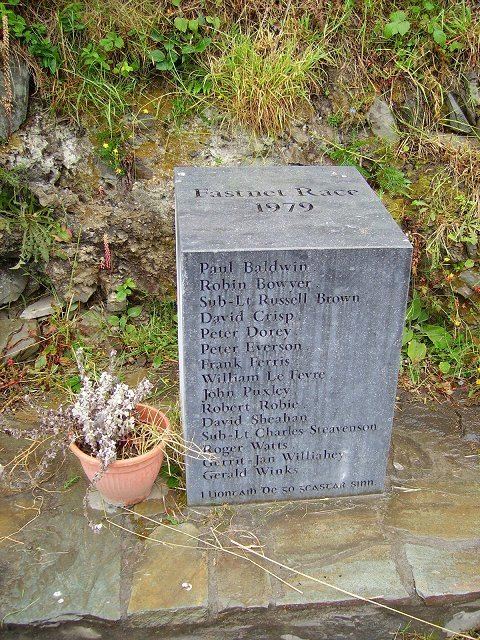 | ||
The 1979 Fastnet race was the twenty-eighth Royal Ocean Racing Club's Fastnet race, a yachting race held generally every two years since 1925 on a 605-mile course from Cowes direct to the Fastnet Rock and then to Plymouth via south of the Isles of Scilly. In 1979, it was the climax of the five-race Admiral's Cup competition, as it had been since 1957.
Contents
- Build up
- Meteorological history
- The disaster and rescue mission
- Finish line
- Vessels that did not finish
- Craft that assisted the rescue mission
- Key contributors to the rescue
- Yachtsmen killed
- References
A worse-than-expected storm on the third day of the race wreaked havoc on over 306 yachts taking part in the biennial race, resulting in 18 fatalities (15 yachtsmen and 3 rescuers). Emergency services, naval forces, and civilian vessels from around the west side of the English Channel were summoned to aid what became the largest ever rescue operation in peace-time. This involved some 4,000 people including the entire Irish Naval Service's fleet, lifeboats, commercial boats, and helicopters.
Build-up
The 1979 race started on 11 August. BBC Radio shipping forecast, broadcast at 13:55 that day predicted "south-westerly winds, force four to five increasing to force six to seven for a time." By 13 August, winds were reported at Force 6, with gusts of Force 7. Forecasters were predicting winds of Force 8. The leading boat, Kialoa, trailed closely by Condor of Bermuda, was on course to break the Fastnet record set eight years earlier.
Meteorological history
A large depression, known as "low Y," formed over the Atlantic Ocean during the weekend of 11–12 August. On 13 August it began to rapidly intensify and turn northeastwards, reaching about 200 nautical miles southwest of Ireland. By the 14th, the low was centred over Wexford. Land-based weather stations reported gale-force winds, with the strongest winds out to sea over the race area. The Meteorological Office assessed the maximum winds as force 10 on the Beaufort scale; many race competitors believed the winds to have reached force 11. Lowest pressure was 979 hPa.
The disaster and rescue mission
Over 13–14 August, of the 306 yachts taking part, 5 were sunk, 100 suffered knock downs, and 77 rolled (that is turtled) at least once due to high winds and "mountainous seas". The Daily Telegraph (15 August 1979, p. 1) described the situation, where "Royal Navy ships, RAF Nimrod jets, helicopters, lifeboats, a Dutch warship Hr MS. Overijssel and other craft picked up 125 yachtsmen whose boats had been caught in force 11 violent storm strength gusts midway between Land's End and Fastnet". The effort also included tugs, trawlers, and tankers. Rescue efforts began after 6:30 am on 14 August, once the winds had dropped to severe gale Force 9.
"15 sailors died, five boats sank, and at least 75 boats flipped upside down." In any event, adopting heaving to as a storm tactic proved to be a good preventive of capsize and turtling during the race. Not one of the hove to yachts were capsized or suffered any serious damage. This seminal disaster resulted in a major rethink of racing, risks and prevention.
The coastguard requested support resulting in a Nimrod from Kinloss being ordered to the scene to act as the Scene of Search Coordinator. As the scale of the disaster became apparent other rescue assets were requested and HMS Broadsword was ordered to the scene taking over as the Scene of Search Coordinator on arrival 17:30 on 14 August.
Finish line
The corrected-time (i.e. handicap) winner was the yacht Tenacious, designed by Sparkman & Stephens, owned and skippered by Ted Turner.
The winner on elapsed time in the race was the 77-foot SV Condor of Bermuda skippered by Peter Blake, which gained around 90 minutes on the leader at the Fastnet rock, the SV Kialoa by chancing a spinnaker. Jim Kilroy of the Kialoa had broken his ribs and there was damage to the yacht's runners. SV Condor of Bermuda broke the Fastnet record by nearly eight hours (71h25m23s).
Vessels that did not finish
Of the 303 starters, only 86 finished. There were 194 retirements and 24 abandonments (five of which were "lost believed sunk").
Early press reports were often confused. The Daily Telegraph reported that 69 yachts did not finish, listed here.
Main source: Daily Telegraph, p. 3, 16 August 1979.
Craft that assisted the rescue mission
Over 4000 people aided in the rescue efforts. The Royal Navy coordinated efforts to find around 80 vessels and rescue 136 crew members.
Key contributors to the rescue
These RNLI lifeboats spent 75 hours at sea in 60-knot (110 km/h) winds
Yachtsmen killed
The Fastnet Race Memorial at Holy Trinity Church, Cowes, Isle of Wight lists 19 fatalities, the 15 above and Olivia Davidson, John Dix, Richard Pendred & Peter Pickering who were aboard Bucks Fizz (a yacht shadowing the fleet to view the race). Two more (unnamed) may also have been lost from Tempean (not a competitor).
